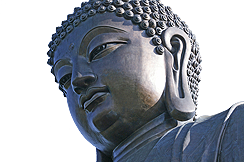
SELF-IMMOLATION in VIETNAM
Fitzgerald, Frances
The historical basis for self-immolation is unclear. The idea of sacrifice is a key in Buddhist thought and self-immolation could be thought of as the ultimate
form of sacrifice. However, it is hard to totally embrace such a violent act, even if it is directed on the self. Scholars believe that the act can be traced back in
history for thousands of years. Thich Nhat Hanh, a well-known authority on Buddhism, believes that the practice of self- immolation may be connected to the ritual of burning incense on one’s body as a form of vow taking. Several sources point to Buddhist scripture, especially the Lotus Sutra, as one possible origin
of the practice.No matter what the specific historical origins are for self-immolation, there is a definite connection between fire and the act of sacrifice. Many stories come to
mind about pagan rituals in which plants or perhaps animals are sacrificed to the gods by fire. Self-immolation can be best thought of as a way of sacrificing
one’s self in the name of ending suffering. In that sense, self-immolation transcends the idea of a religious practice or a political statement and becomes a spiritual plea for peace.One of the earliest known uses of self-immolation as a protest against the Vietnam War is also one of the most famous. On June 16, 1963, Buddhist monk Thich Quang Duc immolated himself in downtown Saigon. Quang Duc was actually protesting religious persecution under the Diem regime, not the war. However, the case could be made that Diem would not have been in power had it not been for U.S. intervention in Vietnam.
Quang Duc's self-immolation was a rallying point for political protest in South Vietnam. Directly following the self-immolation the political climate in Saigon changed as if hit by the drop in pressure preceding a hurricane. Vast demonstrations broke out. The city people, who had for years remained passive, terrified before the Diemist police, crowded into the pagodas to kneel and weep, then, following the bonzes [Buddhist monks], burst forth into the streets calling for the downfall of the Ngos [the ruling family in South Vietnam] (Fitzgerald, 74).
Obviously, Quang Duc's self-immolation had a huge effect on the South Vietnamese population. It is not surprising that Quang Duc's act also affected the Americans who later immolated themselves in protest to the war.
It is important to note that Quang Duc was not the only monk to use self-immolation as a form of protest. On August 16, 1963, only 2 months after Quang
Duc's self-immolation, another monk immolated himself in Phanthiet, about 100 miles from Saigon. The use of self-immolation continued as the war waged on.
In May of 1966, Thich Nu Thanh Quang, a Buddhist nun, immolated herself in the city of Hue.Her death inspired a demonstration of some twenty thousand people in Saigon and a series of eight other self-immolations by Buddhist bonzes and nuns throughout the major cities of Vietnam...President Johnson called the suicides "tragic and unneccessary" and said that they obstructed progress towards holding the elections for a constituent assembly. On May 31, a group of students and Buddhist youths burned down the U.S. consulate in Hue (Fitzgerald, 289).
Again, it seems that the self-immolations were a rallying point for political protest in South Vietnam. While conducting my research, I was suprised to learn that self-immolation is still used today as a form of protest against religious persecution in Vietnam. Although Buddhist officials try to downplay these self-immolations, they admit that that act is often revered by the Vietnamese Buddhist community.
Sources: Fitzgerald, Frances. Fire in the Lake. Boston: Atlantic Monthly, 1972.
Quang Duc, the first Vietnamese monk to self-immolate, in July, 1963. This image is from a painting of the famous news photograph.
The orange-robed monks and the grey-robed nuns appeared to be part of a quiet protest as they walked slowly down Phan-Dinh-Phung Street in Saigon on a hot June afternoon. Heading the procession was an automobile filled with monks. At the intersection of Phan-Dinh-Phung and Le-Van-Duyet streets the priests got out of the car and lifted the hood. It appeared that they were having engine trouble. The procession parted around the car as if to move on, but instead the monks and nuns formed a surrounding circle seven and eight deep. Slowly they began to intone the deep, mournful, resonant rhythm of a sutra. The priests in the auto walked to the center of the circle and seventy-three-year-old Thich Quang-Duc sat in the lotus position, a classic Buddhist meditation pose. Nuns began to weep, their sobs breaking the measure of the chant. A monk removed a five-gallon can of gasoline from the car and poured it over Quang-Duc, who sat calmly in silence as the gasoline soaked his robes and wet the asphalt in a small dark pool. Then Thich Quang-Duc, his Buddhist prayer beads in his right hand, opened a box of matches and struck one. Instantly he was engulfed in a whoosh of flame and heavy black smoke that partially obscured him from view. The chanting stopped. The smoke rose and, as the fierce flames brightened, Quang-Duc's face, his shaven skull and his robes grizzled, then blackened. Amidst the devouring flames his body remained fixed in meditation.
The text was written by Jerrold Shecter and can be found in the book Taking Refuge in L.A. by Rick Fields and Don Farber.



